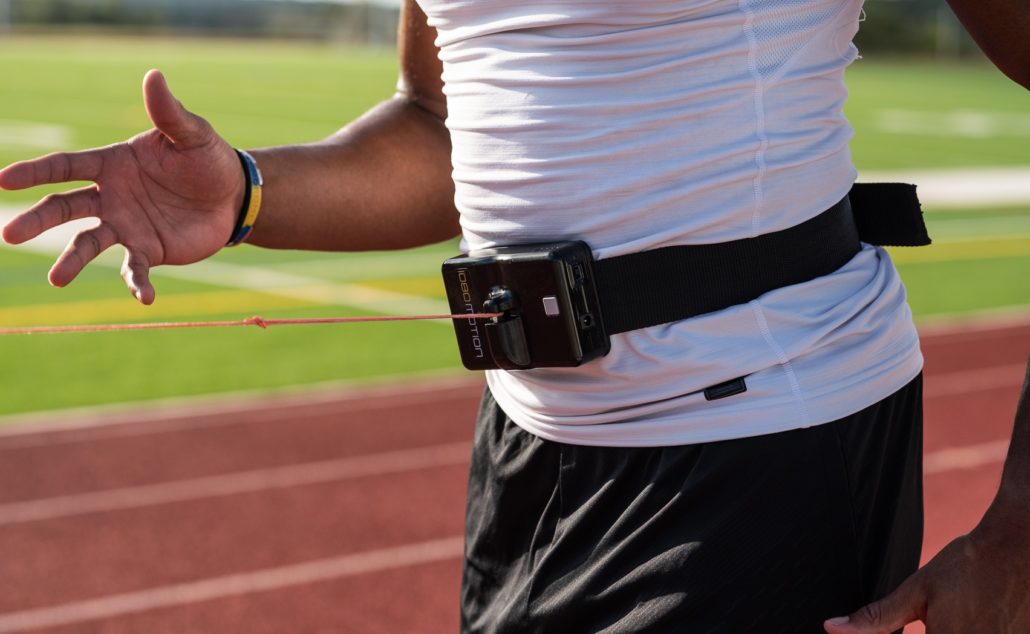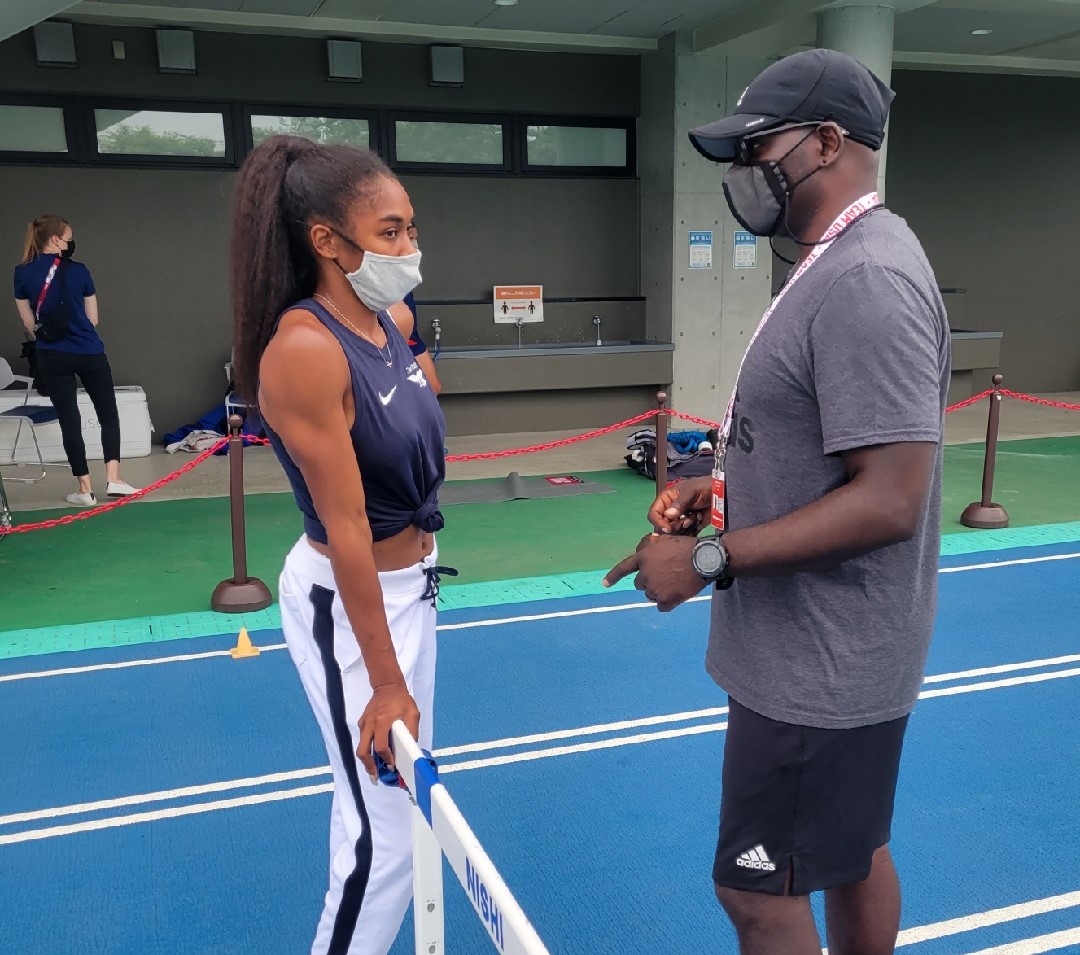The speed development triangle: what the athlete feels, what the coach sees, and what the data reports. In that order, those three qualities dictate the process coach Garfield Ellenwood uses to attack working with his sprinters and hurdlers. Training athletes ranging from college freshman to Olympians, Ellenwood provides continual sprint development—and that’s the key. He’s not just chasing speed and numbers on the 1080 Sprint; he’s fostering long-term progress and longevity in his sprinter’s careers.
Not everything he has experimented with has stuck. Still, with consistent feedback and trust from his athletes—plus data as the final barometer—Ellenwood turns his ideas and intuitions into action. These foundations have guided him through experiences coaching NCAA champions, the Liberian national team, and most recently Christina Clemons, who recently represented the USA Olympic team in the 100m hurdles. Here, those experiences serve as the sparking for a conversation on athlete readiness, individualizing training, and real-time science.
1080 Motion: With consistent success at various levels, looking back, what are a couple of qualities you believe are present in every situation?
Ellenwood: The consistency of the athletes believing in me—and me believing in them. Success comes when we believe in one another and our goal. It’s them trusting me and me trusting that they understand what I’m saying and giving me honest feedback. Even if they don’t necessarily understand it yet, but just giving it a chance. Giving the change a chance because change is hard; change is different. People like to be comfortable, but I have to tell them to get used to being uncomfortable.
1080 Motion: What’s the difference in individualizing your game plan when you’re working with a freshman who’s had limited training and is just very fast versus an Olympian with a training age of at least 5 to 10 years?
Ellenwood: With the freshman athlete, it’s about finding their strengths and weaknesses, and always encouraging them on their strengths. Because with their weaknesses, if they’re not mentally tough, they tend to get frustrated and just go back to what’s comfortable. That’s when I reinforce that you have to be comfortable with being uncomfortable so that uncomfortable becomes comfortable. The biggest challenge is getting that freshman to understand that what you practice will become permanent, so you have always to do it right, over and over and over. With an elite athlete, the fundamentals are there. You’re not taking them from A to Z; you’re taking them from X to Z. It’s just how you implement that X, Y, and Z that’ll create progress, but more from a technical and mental aspect.
1080 Motion: Continuing the example of a freshman with a low training age versus an elite athlete, how do you differentiate your use of the 1080 Sprint between those two athletes in the first few sessions?
Ellenwood: For a college athlete, I just have to get them comfortable with it. I realized that I was starting out too hot and that they were just running. If the 1080 Sprint pulls them fast, they just want to go fast and throw everything else out the window. Do I take the time to develop them, so I don’t have to go back and work on those mechanical issues later? I go with the latter. I want to deal with A and B, so when I get to C and D, I don’t have to go back and deal with A. With an elite athlete, the running postures are usually there and need minimal changes, so I can dial it up a bit more. The elite athletes will still lock in on the little things because they’re seasoned, and the little things mean something to them. You have to know your athlete. Because whether elite or college, they can still get caught up in their own head and forget that it’s about a feeling. If you competed, some of your best races might’ve been a blur, but you remember how they felt. You may not remember what happened, but you can remember that feeling so that you can call on it again.
1080 Motion: Building on the trust and belief, do the 1080 Sprint numbers support what you’re trying to tell them or answer any questions?
Ellenwood: When I first started using it, I tried to get the athletes to understand both with the resistance and assistance on the 1080 Sprint; the goal is trying to get the meters per second up as high as possible. That’s letting them know they’re covering more distance. But by focusing on that, they started changing their running mechanics—over-striding and doing things that I didn’t want. So, I cut the numbers part out completely.
Keeping it simple, I decided to go back to old school to doing my flying 30’s, getting the 10-meter segments, and using the data for me and not for them. I found that athletes these days are always looking for quick answers, but worrying about the numbers was taking away from what I was trying to get them to do and get the feeling of being in the proper position.
1080 Motion: Where does data fit into coaching two intuitive elements of the coach’s eye—individualization and the athlete’s feeling?
Ellenwood: I look at the meters per second (speed); that’s a big part for me. When I go back and look at it after practice—and I’ve digested what they’ve told me and what they’ve felt based on what I saw—I look at the data to see if it matches up with what I saw and what they felt. Once those first two boxes are checked, and that third one (data) is there, then I know I’m on the right track. It’s not until after I talk to them and I can replay what I saw, then I go to the data and pray, please, Lord, let the data match up because if it doesn’t, dang, that means something might’ve fallen off.
1080 Motion: Assisted running is one of the main things you do—why is it so important to you, and what value do your athletes get from this?
Ellenwood: Assisted running allows you to lock that rhythm in. Once the athletes know they can take their body there (to higher velocities) and believe they can do it again and again, that’s when they start to lock into that rhythm. Assistance also increases their stride length—but you want them to understand that assisted running allows them to cover ground as long as they go with it. You can’t pull back; when you pull back, that’s when you get hurt. I use the assistance more at the beginning of the season and the resistance more at the end. I went to a lot of the resistance so they could still receive the benefits, and I back-doored it with the assisted. I only did that every 2-3 weeks later on in the season, just to make sure I was able to keep their bodies there and their stride length open.
1080 Motion: With the assistance running and fly work, what’s your go-to use?
Ellenwood: I like the Fly 30 and Fly 60. Especially once I got the remote release, it all came together. I found that when I went back to the assistance and I had the release, and they weren’t afraid, they really got after it from the beginning because we had been doing so much resistance work. When I had the remote release, it was easier because they didn’t’ have to worry about putting it off, getting hurt, or tweaking anything.
Ellenwood is one of the Beta users of the remote release, and his feedback is actively helping 1080 Motion perfect the design. The remote release product is planned to be available to purchase in Q3 2021.
1080 Motion: With the remote release, could you describe how that simple has a ton of value and elevates assisted running?
Ellenwood: It’s 100% a gamechanger from a mental standpoint because my athletes aren’t afraid that they’ll get out of control, or they’ll need to be too conscious of having to reach down and rip it off. It allows more freedom mentally for the athlete and the coach. As the coach, you don’t have to stand by the emergency release because you have control right there in your hand. Or if it looks like they’re really cranking while doing a Flying 60 and they’re in the right position at that 30 [meter], I’ll take it off [remote release] just to get that last 30 without it and see what happens. Some people stick to the plan of whatever they write on paper; I will change in a heartbeat, so the [remote] release gives me the flexibility to do that on the fly.

1080 Motion: What’s been your favorite use of the remote release so far?
Ellenwood: I saw the video of the [remote] release, and I said, ‘I got to have that.’ My favorite has been releasing the resistance to work on the transition. The athletes don’t know when I’m going to let it go [remote release], but they have to stay in the right position. I had a sprinter go from 10.44 to 10.16 from April 17th to May 9th, just with using the release because he got comfortable coming through his transition out of his drive. He could feel it versus me telling him, and it was all because of the [remote] release.
1080 Motion: Having the 1080 Sprint for a year and now recently being a beta user of the remote release, what’s your general process for learning technology?
Ellenwood: Figuring out how it’s going to help you out as a coach with how your mind works. I’m not one to strictly stick to a plan; I have a plan, but it’s all based on what they’re feeling that particular day, what I’m trying to do, and if I can get it done. I would suggest figuring out how the 1080 Sprint is going to fit you best in order to fit the athlete. Same with the remote release. There are so many things that I’m excited about; there are so many things that I’m going to try. I’m never going to not try something at least once. If it works, keep it—and if it doesn’t, throw it out and keep moving.
1080 Motion: With the amount of data with the 1080 Sprint, how do you choose what to disclose to your athletes and when? How do you use that in the teaching process?
Ellenwood: I always use Tyson Gay and Usain Bolt as examples. Usain Bolt ran 9.58 and ran 39 steps; Tyson Gay ran 9.61 and ran 41 steps. The name of the game is covering ground. Cover as much distance as you can per second. I keep it there because these athletes if you give them numbers, they’re going to start coming up with it on their own. The most I’ll say is here you are, and here’s where we’re trying to get to, but we have to do the little things to get there. If you start reaching, I’m shutting you down, and we’re starting everything back over. It’s more of a guide in the process; it’s not an end-all-be-all. It’s just a piece or two in the toolkit. It’s bigger for me, but I don’t want them to know that because they start trying to come up with their own ideas and overthinking. I got this from Coach Holloway; he used to always say, I’ll rob the train, you get the money. Let me do the work, and you reap the benefits.
Garfield Ellenwood is Assistant Coach at the University of Maryland. Previously Associate Head Coach (sprints/hurdles) at Alabama State University.






























































